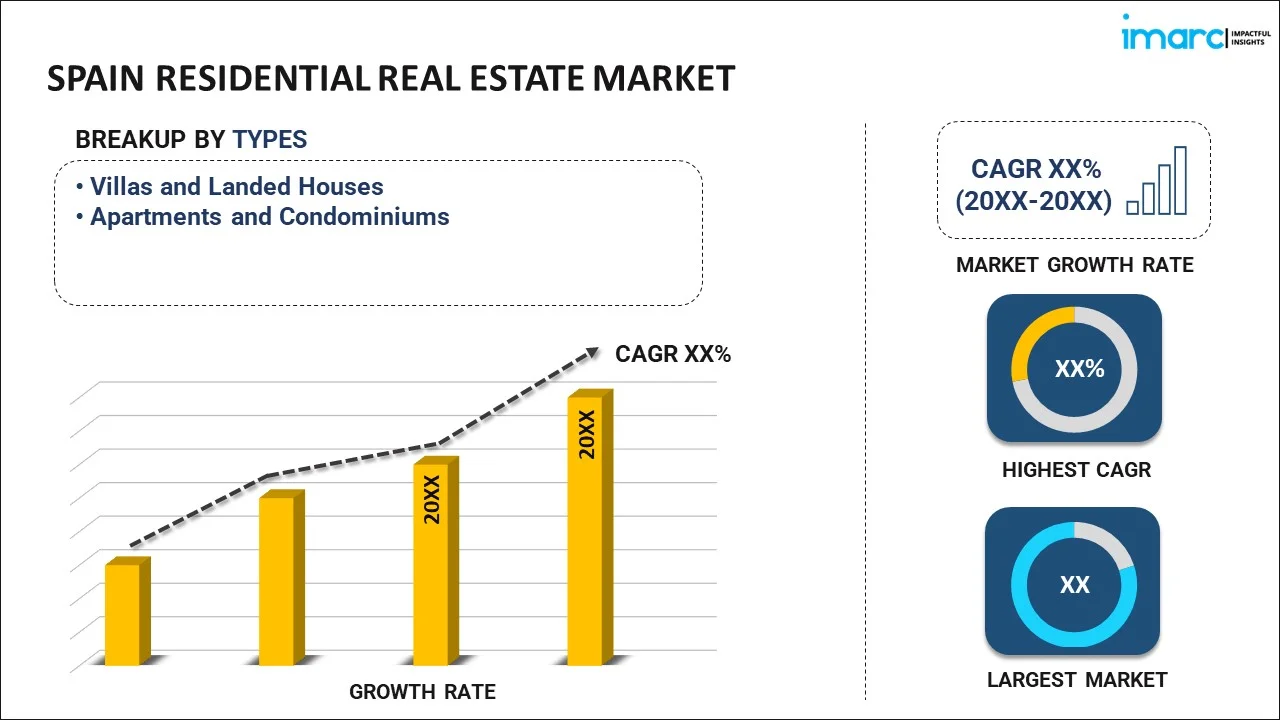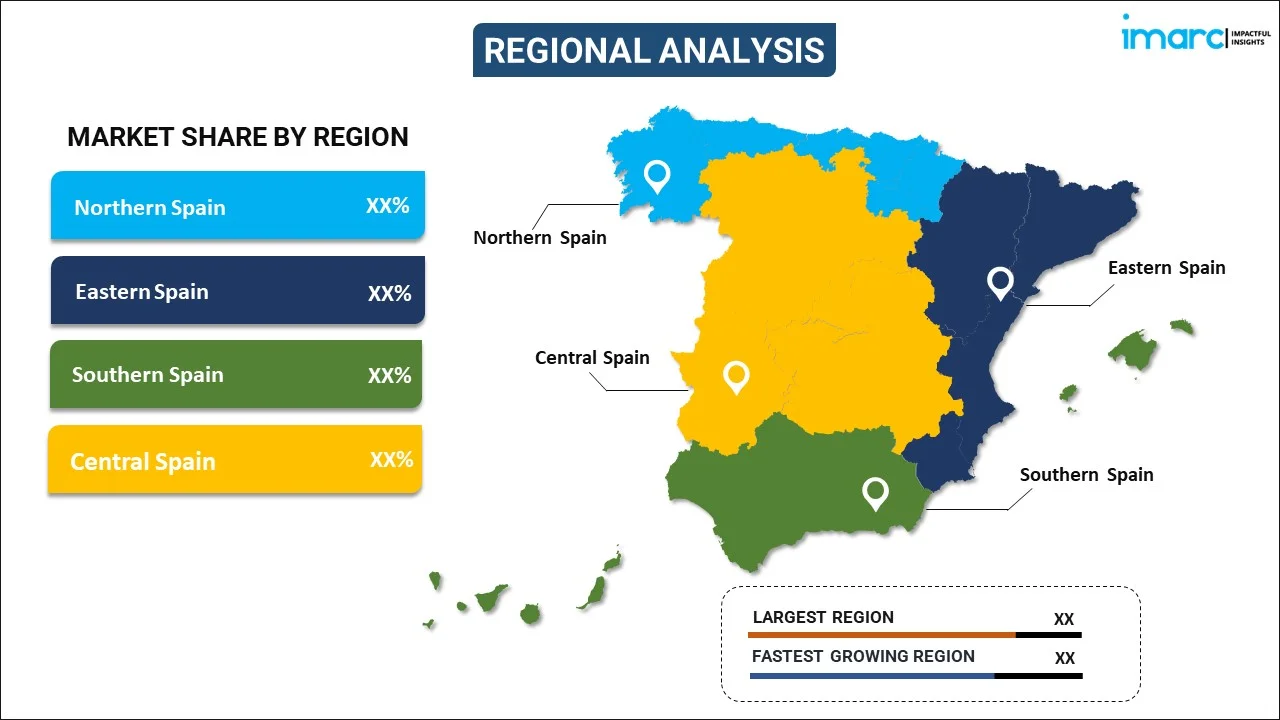
Spain Residential Real Estate Market Report by Type (Villas and Landed Houses, Apartments and Condominiums), and Region 2024-2032
Spain Residential Real Estate Market Overview:
The Spain residential real estate market is projected to exhibit a growth rate (CAGR) of 6.50% during 2024-2032. The rising property purchases by international buyers, extensive demand for modern and sustainable housing, rise in smart home technology, and the increasing interest in co-living spaces among consumers represent some of the key factors driving the growth of the market.
|
Report Attribute
|
Key Statistics
|
|---|---|
|
Base Year
|
2023 |
|
Forecast Years
|
2024-2032
|
|
Historical Years
|
2018-2023
|
| Market Growth Rate (2024-2032) | 6.50% |
Spain Residential Real Estate Market Trends:
Rise in International Property Buyers
The rise in international property buyers is driving the Spain residential real estate market by boosting demand and increasing property values. Foreign investors are attracted to Spain's favorable climate, lifestyle, and investment potential, leading to a surge in property acquisitions. This influx of international buyers stimulates market activity, encourages new developments, and enhances the overall appeal of the residential real estate sector. Additionally, the increased demand from abroad supports economic growth and contributes to a more dynamic and competitive market environment. According to data from the Ministry of Transport, Mobility and Urban Agenda (Mitma), throughout 2022, non-resident foreigners bought 63,050 homes in Spain out of the 717,558 total transactions recorded. In other words, they accounted for 8.78% of the total. In March 2022, 20% of property searches on idealista that came from abroad were concentrated in provinces such as Alicante, Santa Cruz de Tenerife, the Balearic Islands, Girona, Malaga, Las Palmas and Almeria, compared to 12% in Barcelona and 5.5% in Madrid. The average in Spain is 10.6%.
Growing Demand for Modern and Sustainable Housing
Buyers are also showing an increased interest in new and efficient homes that are environmentally sustainable and consume less energy. This trend is fueled by the growing concern for environmental problems and the desire to minimize carbon emissions. For instance, in 2023, EIB Group signed financing agreements worth €11.4 billion for 90 high-impact projects covering public policy goals such as renewable energy, sustainable transport and urban mobility. A record amount of €6.8 billion was invested in green financing. More than €4.5 billion was invested in energy security and more than €2.5 billion in renewable energy. Also, buyers are interested in homes equipped with smart-home technology, including automation for lights, thermostats, security systems, etc. These preferences indicate the current world trends towards more sustainable and high-tech living accommodations. Other factors that affect trends in the Spain residential real estate market include the popularity of co-living apartments in big cities such as Barcelona and Madrid. Co-living addresses the demands of young professionals and students for alternative and cheaper housing, combined with the attractiveness of shared resources, thereby saving costs and offering sustainable solutions.
Spain Residential Real Estate Market News:
- In January 2024, Berkshire Hathaway HomeServices, a global residential real estate brokerage franchise network, expanded its services in Arkansas. This move is aimed at leveraging the power of a global brand that is known for its quality, innovation, and reliability.
- In April 2024, AEDAS Homes, Spain’s benchmark residential developer, reported land investments of more than €220 million during its 2023-24 fiscal year, which ended on 31 March. These transactions have a total development capacity of over 2,500 units and are located in the most attractive and dynamic residential markets across Spain.
Spain Residential Real Estate Market Segmentation:
IMARC Group provides an analysis of the key trends in each segment of the market, along with forecasts at the country level for 2024-2032. Our report has categorized the market based on type.
Type Insights:

- Villas and Landed Houses
- Apartments and Condominiums
The report has provided a detailed breakup and analysis of the market based on the type. This includes villas and landed houses and apartments and condominiums.
Regional Insights:

- Northern Spain
- Eastern Spain
- Southern Spain
- Central Spain
The report has also provided a comprehensive analysis of all the major regional markets, which include Northern Spain, Eastern Spain, Southern Spain, and Central Spain.
Competitive Landscape:
The market research report has also provided a comprehensive analysis of the competitive landscape. Competitive analysis such as market structure, key player positioning, top winning strategies, competitive dashboard, and company evaluation quadrant has been covered in the report. Also, detailed profiles of all major companies have been provided.
Spain Residential Real Estate Market Report Coverage:
| Report Features | Details |
|---|---|
| Base Year of the Analysis | 2023 |
| Historical Period | 2018-2023 |
| Forecast Period | 2024-2032 |
| Units | xx |
| Scope of the Report | Exploration of Historical Trends and Market Outlook, Industry Catalysts and Challenges, Segment-Wise Historical and Future Market Assessment:
|
| Types Covered | Villas and Landed Houses, Apartments and Condominiums |
| Regions Covered | Northern Spain, Eastern Spain, Southern Spain, Central Spain |
| Customization Scope | 10% Free Customization |
| Post-Sale Analyst Support | 10-12 Weeks |
| Delivery Format | PDF and Excel through Email (We can also provide the editable version of the report in PPT/Word format on special request) |
Key Questions Answered in This Report:
- How has the Spain residential real estate market performed so far and how will it perform in the coming years?
- What has been the impact of COVID-19 on the Spain residential real estate market?
- What is the breakup of the Spain residential real estate market on the basis of type?
- What are the various stages in the value chain of the Spain residential real estate market?
- What are the key driving factors and challenges in the Spain residential real estate?
- What is the structure of the Spain residential real estate market and who are the key players?
- What is the degree of competition in the Spain residential real estate market?
Key Benefits for Stakeholders:
- IMARC’s industry report offers a comprehensive quantitative analysis of various market segments, historical and current market trends, market forecasts, and dynamics of the Spain residential real estate market from 2018-2032.
- The research report provides the latest information on the market drivers, challenges, and opportunities in the Spain residential real estate market.
- Porter's five forces analysis assist stakeholders in assessing the impact of new entrants, competitive rivalry, supplier power, buyer power, and the threat of substitution. It helps stakeholders to analyze the level of competition within the Spain residential real estate industry and its attractiveness.
- Competitive landscape allows stakeholders to understand their competitive environment and provides an insight into the current positions of key players in the market.
Need more help?
- Speak to our experienced analysts for insights on the current market scenarios.
- Include additional segments and countries to customize the report as per your requirement.
- Gain an unparalleled competitive advantage in your domain by understanding how to utilize the report and positively impacting your operations and revenue.
- For further assistance, please connect with our analysts.
 Inquire Before Buying
Inquire Before Buying
 Speak to an Analyst
Speak to an Analyst
 Request Brochure
Request Brochure
 Request Customization
Request Customization




.webp)




.webp)












